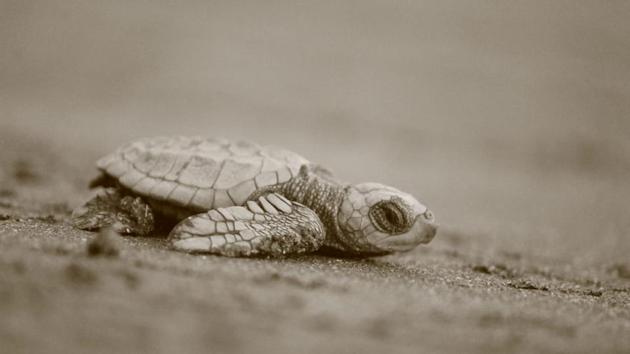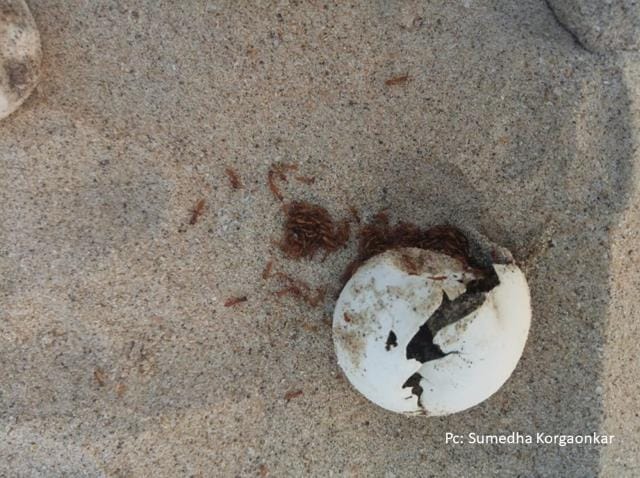Researchers come up with natural solution to prevent red ants from attacking Olive Ridley turtle nests in Maharashtra
By maintaining a safe distance from the nest, protective layers were carved out sprayed with neem powder
A first-of-its-kind study in India, researchers have tried to combat the problem of red army ants predating on Olive Ridley turtle eggs and hatchlings, and have found natural control measures to protect nesting sites for further conservation of the species.

During the 2018-19 turtle nesting period along Maharashtra’s west coast, local turtle conservationist Suhas Toraskar at Wayangani Beach in Vengurla, Sindhudurg, was startled to discover predating ants on protected hatchling sites. The nesting period saw more than 75% nests infested with red ants, which caused four of seven nests with over 500 eggs (one nest has around 125 eggs on average) to be completely devoured, resulting in an extremely low hatchling survival rate. Owing to a lack of any detailed study, conservationists were left clueless on how to protect these species and reached out to the forest department for help.
Funded by the Mangrove and Marine Biodiversity Conservation Foundation –an autonomous body that assists the state mangrove cell (under the forest department) in coastal marine conservation through research projects – Anuja Vartak from the department of biodiversity, MES Abasaheb Garware College, Pune, under the supervision of Sumedha Korgaonkar, research scholar, Wildlife Institute of India, Dehradun, commenced a study from December 2019 to understand the feeding, foraging and predatory behaviour of this ant species during the nesting season and find a solution to prevent predation.
“This is the first time that any study from the Indian subcontinent has identified ant species responsible for predatory behaviour affecting turtles. It has provided a roadmap for species conservation for the west coast and across India,” said Virendra Tiwari, additional principal chief conservator of forest (mangrove cell) and executive director, Mangrove Foundation.
Researchers identified that changes in weather pattern have led to a shift in turtle nesting months, followed by the ant attack.
“After assessing turtle nesting data of the past 20 years, a prominent shift in the peak nesting season was identified along Maharashtra. The nest and its incubation period had shifted to the summer months of March-April instead of January-February, most likely owing to the impacts of climate change,” said Korgaonkar, adding that coincidentally, the predation of protected and relocated nests increased at Wayangani.
Though natural predators such as golden jackals, birds, feral dogs etc. are known to predate on emerging sea turtle hatchlings, hatcheries can be protected by building sheds, protective cover or relocating the nests.
“However, in this case, the attacks were happening through the sand as these insects would already demolish nests by the time a hatchery could be excavated,” said Korgaonkar.
After collecting samples, researchers with help from expert Dr Himender Bharti, identified the ant species as Dorylus orientalis (commonly called blind ant or red ant). It is native to the Indian subcontinent and known to be an agricultural pest that attacks potato and groundnut crops.
“In this case, the nesting site did not have these crops but our survey with locals revealed that these ants were present in these areas for over three decades, which meant they were an ecological indicator,” said Vartak.

Meanwhile, the research team’s investigation also revealed that beach managers were using chemical insecticide (phorate powder) a few metres away from nests.
“This was harmful to the ecosystem as well as dangerous for the developing turtle embryos,” added Korgaonkar.
Finally, researchers came up with a natural solution using neem (Azadirachta indica) powder as an eco-friendly control measure by identifying ant tunnels along nesting beaches. By maintaining a safe distance from the nest, protective layers were carved out sprayed with neem powder.
“We found the solution was 100% effective with not a single case of predation or destruction of eggs during the 2019-20 season at Wayangani Beach. However, the solution is not locally available and a more native eco-friendly measure is being sought under the next phase of the study,” said Korgaonkar.
The Mangrove Foundation said methods suggested would be implemented wherever such predation was observed along the state coastline.
“The problem of red ants predating on turtle eggs has been documented at some sites along the Maharashtra coast and this short study shows us that there are some simple biological control methods which can be employed to deal with this problem. Thus in the future, such measures will be used to counter these problems,” said Manas Manjrekar, deputy director, Mangrove Foundation.
Though the second phase for the research work – identifying a locally available natural solution for the problem – was delayed due to Covid-19, researchers will recommence the study during the 2020-21 nesting season.
“Our research has been the first evidence of red ant predation on sea turtles reported from India. Being a vulnerable species, such behavioural research has assumed top priority for conservationists worldwide, furthering the effectiveness of conservation management,” said Vartak, adding, “Once the study resumes we hope to develop a low-cost, locally available natural solution to prevent ant attacks on the vulnerable hatchlings.”
Among the smallest of the world’s sea turtles
Named for the greenish colour of its skin and shell, Olive Ridley sea turtles are found in warm tropical currents of the Indian and Pacific Oceans. Along with the Kemp’s Ridley, they are known to be among the smallest of the sea turtles globally. They are protected under Schedule I of the Wildlife Protection Act, 1972, and classified as vulnerable by the International Union for Conservation of Nature’s (IUCN) Red List and travel thousands of kilometres in the ocean, with only the females returning to their original nesting sites within a minimum of two years to lay eggs. After a 45-65 day incubation period, juvenile turtles break the eggshell, dig through the sand, and crawl to the sea. While females return to their place of birth, males never return to land. Female turtles use geomagnetic imprinting (navigating to their geographic area of origin using magnetic field) and olfactory (relating to the sense of smell) cues to find their natal areas. According to the mangrove cell, only two-fifths of all Olive Ridley turtle hatchlings made their way to the sea in Maharashtra in 2019-20 with 12,149 hatchlings survived from 27,254 eggs during the period, accounting for a survival rate of 44.5%. In 2018-19, the survival rate was 54.4% with 12,601 hatchlings that made it to sea from 23,131 eggs.
Stay updated with all the Breaking News and Latest News from Mumbai. Click here for comprehensive coverage of top Cities including Bengaluru, Delhi, Hyderabad, and more across India along with Stay informed on the latest happenings in World News.
Stay updated with all the Breaking News and Latest News from Mumbai. Click here for comprehensive coverage of top Cities including Bengaluru, Delhi, Hyderabad, and more across India along with Stay informed on the latest happenings in World News.





